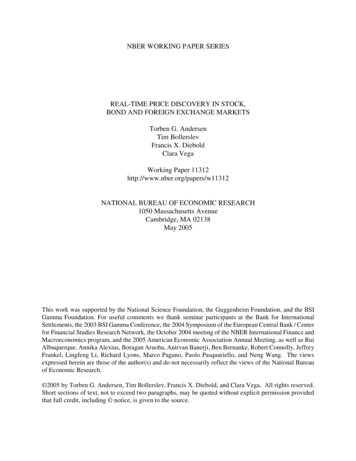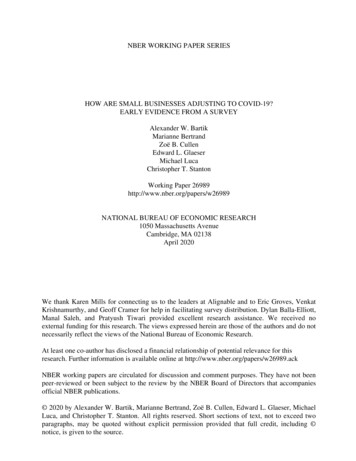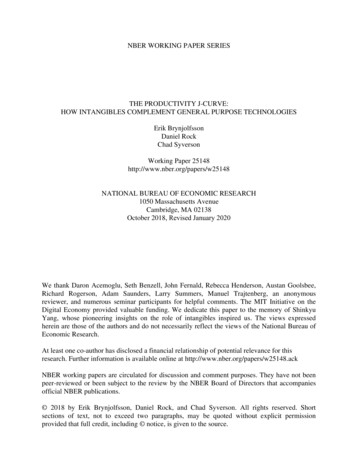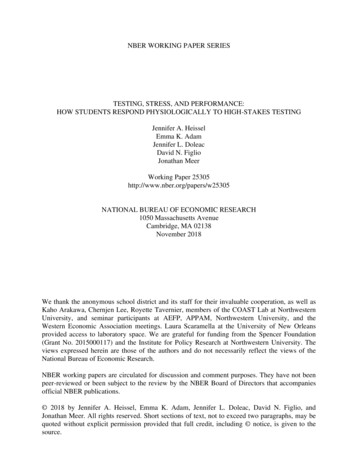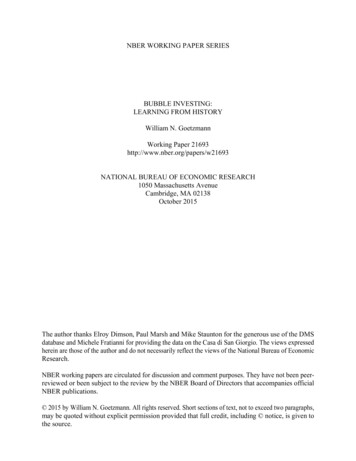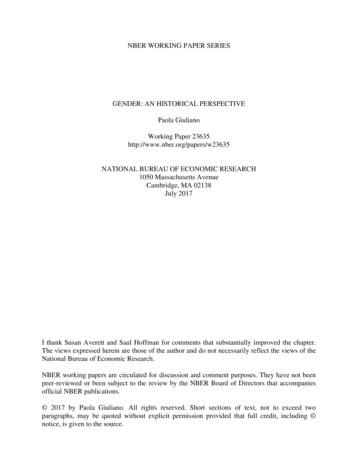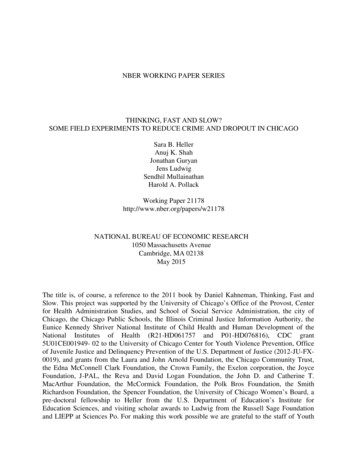
Transcription
NBER WORKING PAPER SERIESTHINKING, FAST AND SLOW?SOME FIELD EXPERIMENTS TO REDUCE CRIME AND DROPOUT IN CHICAGOSara B. HellerAnuj K. ShahJonathan GuryanJens LudwigSendhil MullainathanHarold A. PollackWorking Paper 21178http://www.nber.org/papers/w21178NATIONAL BUREAU OF ECONOMIC RESEARCH1050 Massachusetts AvenueCambridge, MA 02138May 2015The title is, of course, a reference to the 2011 book by Daniel Kahneman, Thinking, Fast andSlow. This project was supported by the University of Chicago’s Office of the Provost, Centerfor Health Administration Studies, and School of Social Service Administration, the city ofChicago, the Chicago Public Schools, the Illinois Criminal Justice Information Authority, theEunice Kennedy Shriver National Institute of Child Health and Human Development of theNational Institutes of Health (R21-HD061757 and P01-HD076816), CDC grant5U01CE001949- 02 to the University of Chicago Center for Youth Violence Prevention, Officeof Juvenile Justice and Delinquency Prevention of the U.S. Department of Justice (2012-JU-FX0019), and grants from the Laura and John Arnold Foundation, the Chicago Community Trust,the Edna McConnell Clark Foundation, the Crown Family, the Exelon corporation, the JoyceFoundation, J-PAL, the Reva and David Logan Foundation, the John D. and Catherine T.MacArthur Foundation, the McCormick Foundation, the Polk Bros Foundation, the SmithRichardson Foundation, the Spencer Foundation, the University of Chicago Women’s Board, apre-doctoral fellowship to Heller from the U.S. Department of Education’s Institute forEducation Sciences, and visiting scholar awards to Ludwig from the Russell Sage Foundationand LIEPP at Sciences Po. For making this work possible we are grateful to the staff of Youth
Guidance, World Sport Chicago, the Chicago Public Schools, and the Cook County JuvenileTemporary Detention Center, and to Ellen Alberding, Roseanna Ander, Mayor Richard M.Daley, Anthony Ramirez- DiVittorio, Earl Dunlap, Mayor Rahm Emanuel, Wendy Fine,Hon. Curtis Heaston, Michelle Morrison, Dave Roush, and Robert Tracy. For helpfulcomments we thank Larry Katz, Andrei Shleifer, four anonymous referees, StefanoDellaVigna, Dan Gilbert, John Rickford, and seminar participants at Case Western, Columbia,Duke, Erasmus, Harvard, MDRC, Notre Dame, Northwestern, Sciences Po, Stanford,University of Chicago, University of Miami, University of Michigan, University ofPennsylvania, University of Toronto, University of Virginia, University of Wisconsin, Yale,the MacArthur Foundation, NBER, New York City Department of Probation, and the jointNew York Federal Reserve / NYU education workshop. For help accessing administrative datawe thank the Chicago Public Schools, the Chicago Police Department, and ICJIA, forproviding Illinois Criminal History Record Information through an agreement with the IllinoisState Police. For invaluable help with monitoring, data collection, and analysis we thankNour Abdul-Razzak, Sam Canas, Brice Cooke, Stephen Coussens, Gretchen Cusick,Jonathan Davis, Nathan Hess, Anindya Kundu, Heather Sophia Lee, Duff Morton, KylePratt, Julia Quinn, Kelsey Reid, Catherine Schwarz, David Showalter, Maitreyi Sistla,Matthew Veldman, Robert Webber, David Welgus, John Wolf, and Sabrina Yusuf. Thefindings and opinions expressed here are those of the authors and do not necessarily reflect thoseof the Department of Justice, National Institutes of Health, the Centers for Disease Control, anyother funder or data provider, or the National Bureau of Economic Research.NBER working papers are circulated for discussion and comment purposes. They have not beenpeer-reviewed or been subject to the review by the NBER Board of Directors that accompaniesofficial NBER publications. 2016 by Sara B. Heller, Anuj K. Shah, Jonathan Guryan, Jens Ludwig, SendhilMullainathan, and Harold A. Pollack. All rights reserved. Short sections of text, not to exceedtwo paragraphs, may be quoted without explicit permission.
Thinking, Fast and Slow? Some Field Experiments to Reduce Crime and Dropout in ChicagoSara B. Heller, Anuj K. Shah, Jonathan Guryan, Jens Ludwig, Sendhil Mullainathan, and HaroldA. PollackNBER Working Paper No. 21178May 2015, Revised June 2016JEL No. C91,C93,D03,D1,I24,I3,I32,K42ABSTRACTWe present the results of three large-scale randomized controlled trials (RCTs) carried out inChicago, testing interventions to reduce crime and dropout by changing the decision-making ofeconomically disadvantaged youth. We study a program called Becoming a Man (BAM),developed by the non-profit Youth Guidance, in two RCTs implemented in 2009–10 and 2013–15. In the two studies participation in the program reduced total arrests during the interventionperiod by 28–35%, reduced violent-crime arrests by 45–50%, improved school engagement, andin the first study where we have follow-up data, increased graduation rates by 12–19%. The thirdRCT tested a program with partially overlapping components carried out in the Cook CountyJuvenile Temporary Detention Center (JTDC), which reduced readmission rates to the facility by21%. These large behavioral responses combined with modest program costs imply benefit-costratios for these interventions from 5-to-1 up to 30-to-1 or more. Our data on mechanisms are notideal, but we find no positive evidence that these effects are due to changes in emotionalintelligence or social skills, self-control or “grit,” or a generic mentoring effect. We findsuggestive support for the hypothesis that the programs work by helping youth slow down andreflect on whether their automatic thoughts and behaviors are well suited to the situation they arein, or whether the situation could be construed differently.Sara B. HellerDepartment of CriminologyUniversity of PennsylvaniaMcNeil Building, Suite 5713718 Locust WalkPhiladelphia, PA 19104hellersa@sas.upenn.eduAnuj K. ShahBooth School of BusinessUniversity of Chicago5807 South Woodlawn AvenueChicago, IL 60637anuj.shah@chicagobooth.eduJonathan GuryanNorthwestern UniversityInstitute for Policy Research2040 Sheridan RoadEvanston, IL 60208and NBERj-guryan@northwestern.eduJens LudwigUniversity of Chicago1155 East 60th StreetChicago, IL 60637and NBERjludwig@uchicago.eduSendhil MullainathanDepartment of EconomicsLittauer M-18Harvard UniversityCambridge, MA 02138and Consumer Financial Protection Bureauand also NBERmullain@fas.harvard.eduHarold A. PollackUniversity of ChicagoSchool of Social Service Administration969 East 60th StreetChicago, IL 60637haroldp@uchicago.eduA online appendix is available at http://www.nber.org/data-appendix/w21178
I. INTRODUCTIONDisparities in youth outcomes in the United States are striking. For example, for 15–24year olds, the male homicide rate in 2013 was 18 times higher for blacks than whites (71 versus4 per 100,000). 1 Black males lose more years of potential life before age 65 to homicide than toAmerica’s leading overall killer—heart disease. 2 A large body of research emphasizes that—beyond institutional factors—choices and behavior also contribute to these outcomes, includingdecisions around dropping out of high school, involvement with drugs or gangs, or responses toconfrontations that could escalate to serious violence. In this paper we present the results of threelarge-scale randomized controlled trials (RCTs) that seek to reduce crime and dropout bychanging the decision-making of disadvantaged youth at elevated risk for these outcomes.Given the current focus of US social policies aimed at changing these behaviors, onenoteworthy feature of the interventions we study is what they are not. They do not involve earlychildhood education, or academic skill development, or vocational or technical training, orsubsidized jobs or internships, or cash transfers, or in-kind supports, or efforts to changeparenting or the home environment, or any sort of incentive scheme for children, parents, orteachers. Another noteworthy feature is that, unlike most previous interventions for low-incomeyouth, those we study here seem to generate large impacts on important behavioral outcomes.To provide some concrete sense of what the programs are, we describe the first activityyouth do in one of the programs we study: the Becoming a Man (BAM) program developed bythe Chicago non-profit Youth Guidance (YG). Students are divided into pairs and one is given aball, which the other student is told he has 30 seconds to get from his partner. Almost all youthuse physical force to try to take the ball out of the other’s fist. During the debrief, the group1Our calculations compare non-Hispanic blacks to whites, and focus on homicides (excluding fatalities from legalintervention); see WISQARS (http://webappa.cdc.gov/sasweb/ncipc/mortrate10 us.html).2WISQARS (http://webappa.cdc.gov/sasweb/ncipc/ypll10.html)3
leader points out that no one simply asked for the ball. When prompted about why they did notsimply ask, most respond with some version of “he wouldn’t have given it,” or “he would havethought I was a punk.” The leader then asks the other youth, “How would you have reacted ifasked nicely for the ball?” The answer typically is something like, “I would have given it; it’sjust a stupid ball.” This exercise, like many in the program, teaches youth to think more carefullyabout the situations they are in.The interventions we study here were carried out in very disadvantaged neighborhoods onthe south and west sides of Chicago. Our first two RCTs tested BAM, first randomizing 2,740youth to a one-year program in the 2009–10 academic year (AY), with the second RCTstretching the curriculum out over two years in AYs 2013–14 and 2014–15 with 2,064 youth. 3We measure outcomes with longitudinal government administrative data. In both studies theeffect on program participants during the program period were similar, reducing total arrests by28–35%, violent-crime arrests by 45–50%, and arrests for other crimes by 37–43%. While theseimpacts on arrests did not persist beyond the program period in the first BAM study (we do nothave post-program data for the second BAM study), we did find persistent impacts on schoolingoutcomes—including gains in high school graduation rates of 6 to 9 percentage points (12–19%).Our third RCT was carried out in a very different setting—the Cook County, IllinoisJuvenile Temporary Detention Center (JTDC), where high-risk juvenile arrestees in the Chicagoarea are taken for pre-trial detention. The intervention, carried out in some residential units in theJTDC but not others, consisted of a package of reforms that included a token economy for goodbehavior inside the facility, increased educational requirements for staff, and a daily programdelivered by the detention center’s staff that had many elements similar in spirit to BAM. We3The program is also abbreviated as “B.A.M.” but for consistency we use a common style for all acronyms. Someyouth also received after-school programming developed to reinforce the BAM curriculum by a non-profit calledWorld Sport Chicago. We argue below that our results are not due simply to incapacitation of youth during afterschool hours when sports were held, nor to sports more generally.4
focus on the 2,693 male admissions to the JTDC from 2009–11 who were randomly assigned tounits with or without the reforms, and for whom we have at least 18 months of follow-up data.Receipt of programming reduced re-admission rates by 16 percentage points (21%) and hadimpacts on the number of readmissions or readmissions plus arrests that were similarly large butsometimes less precisely estimated.What is striking about these interventions is not just that they generated such largebehavioral responses, but also that they were able to do so at relatively low cost—less than 2,000 per participant (and sometimes much less). In our first BAM RCT, for which we have themost complete data on outcomes, we estimate that the value of crime reduction alone yieldsbenefit-cost ratios that range from 5-to-1 up to 30-to-1. These are likely to be lower-boundestimates, given our findings that BAM increases high school graduation rates as well.Why do these programs work so well? Existing theories of what (beyond academic skills)determines people’s life outcomes suggest a few possible channels such as self-control,conscientiousness, “grit,” emotional intelligence, social skills, support from pro-social adults(“social capital”), or an understanding of the returns to education. To measure these candidatemechanisms we have surveys administered throughout the Chicago Public School (CPS) system,including to youth in our first BAM study. These data are not totally ideal, partly because theycaptured responses from just under half of the youth in our study and partly because they did notcapture measures related to every possibly-relevant theory from the prior literature. With thesecaveats in mind, we find no positive evidence that any of the candidate mechanisms suggested byprior research for which we have measures explain much of the treatment effect. Our estimatesof treatment effects on these potential mediators, and the relationship between mediators andoutcomes, suggest these mechanisms are unlikely to account for more than a modest share of theprogram effects on behavioral outcomes. Using arrest records with exact date of arrest, we can5
also rule out that the effects were due merely to keeping youth busy (voluntary incapacitation) ondays when after-school activities occurred.When we look at the curricula for the programs we study here we can see why commonlydiscussed mechanisms do not seem so important for these interventions. Consider, for example,BAM’s “fist” exercise described above. This does not seem to act on commonly discussedmechanisms like self-control or social skills or grit. The exercise does not help youth learn howto either recognize or stifle feelings of anger, or learn the most polite way to request the ball, orhow to persist in trying to get the ball. Many other BAM activities are similar in that regard.Another noteworthy aspect of the fist exercise (and the BAM program as a whole) is thatit does not tell youth the “right” thing to do. BAM providers recognize that these youth live indistressed neighborhoods where being aggressive or even fighting may—unfortunately—sometimes be necessary to avoid developing a reputation as someone who is an easy victim. It isnot hard to see how someone navigating that sort of neighborhood environment could develop atendency to reflexively push back against being challenged. That response can lead to trouble ifit is over-generalized and sometimes applied in settings where it is not helpful—such as school.This illustrates our own hypothesis for why these programs change youth behavior, basedon the psychology of automaticity. 4 Because conscious deliberation is mentally costly, all of usdevelop a series of automatic responses that are usually adaptive to situations that we commonlyface—such as youth in distressed urban neighborhoods fighting back aggressively whenchallenged. Why might a teenager over-generalize and deploy this response in a setting where itis not adaptive, such as in school? Behavioral science shows that we all make automaticassumptions about what situation we are in and that these assumptions can sometimes be wrong4Within psychology automaticity is most notably associated with dual systems models, which are well summarizedin Kahneman (2011). Other economic models of dual systems thinking include Cunningham (2015) and for impulsecontrol Fudenberg and Levine (2006).6
(Ross and Nisbett 2011). Being yelled at by a teacher in school to stop talking so class can beginmay at first glance feel like one’s reputation is being challenged, just as on the street. Wehypothesize that these interventions improve youth outcomes in substantial part because theyhelp youth slow down in high-stakes settings, examine their automatic assumptions about whatsituation they are in, and ask whether the situation could be construed differently. That is, theprograms help youth have a greater sense of occasion. 5The difference between this theory and other commonly discussed mechanisms ishighlighted by the fact that the BAM providers say some of their youth have the problem of notbeing aggressive enough. That is, rather than having the problem of taking the automaticresponse adaptive for the neighborhood and over-generalizing to the school setting, some youthhave the opposite problem of over-generalizing the response that is adaptive for school—whichin turn gets them into trouble in the neighborhood. For these youth, BAM can have the effect ofincreasing the frequency with which they assert themselves—ideally only in the right situations.To test this theory, we administered a decision-making exercise (an iterated dictatorgame) to about half of the youth in our second BAM study. This exercise made youth think theyhad been provoked by a classmate and then gave them a chance to retaliate. Our theory predictsBAM youth should slow down and spend more time thinking about how to respond. Our theorydoes not predict how they will respond, since that depends on what situation they construethemselves to be in. Consistent with our theory, BAM increased decision-making time inresponse to the provocation by 80%. In terms of the amount of retaliation administered, wefound few differences between BAM youth and controls, which does not seem consistent withmechanisms that emphasize changes in factors that would make youth uniformly more “prosocial” across all situations.5We thank our colleague Dan Gilbert for suggesting this wonderful phrase.7
This hypothesis gives us a way to understand why these interventions are more successfulthan so many previous efforts. Many social policies intended to help disadvantaged youth try tochange behavior by changing the long-term returns to pro- or anti-social behavior, usually withdisappointing results. More promising may be to directly help youth recognize their automaticassumptions and responses and make better decisions in high-stakes situations. As one JTDCstaff member told us, “20% of our residents are criminals; they will harm other people if they arenot locked up. But the other 80%, I always tell them—if I could give you back just 10 minutes ofyour lives, you wouldn’t be here.” 6II. INTERVENTION STRATEGYThis section describes the two interventions we study, key parts of which may be lumpedtogether under the broad heading of what psychologists call cognitive behavioral therapy (CBT).CBT is designed to get youth to “think about their thinking,” or engage in “meta-cognition”(Beck 2011). 7 There are other elements of the two programs we study that only partially overlap.This provides us with one source of leverage for learning more about underlying mechanisms.A. BECOMING A MAN (BAM)The Becoming a Man program was developed by Youth Guidance about a decade beforeour first RCT of the program in AY 2009–10. The program was operating in a single Chicagohigh school and a few elementary schools before being taken to scale for our RCT. In the firstexperiment, BAM offered youth the opportunity to participate in 27 one-hour, once-per-week6Personal communication, Darrien McKinney to Jens Ludwig, Sendhil Mullainathan, and Anuj Shah, 10/18/2012.CBT programs vary in their focus, including the degree to which they try to reduce automaticity, and not allinterventions to reduce automaticity will necessarily be called CBT. Since the 1970s, CBT has been used to addressmental health disorders such as substance abuse, anxiety, and depression, and can be more effective than antidepressant drugs (Rush, et al. 1977). Since then, there has been growing practitioner interest in using differentversions of CBT as a social policy tool to address socially costly behaviors. Yet there is little good evidencecurrently about effects on those behaviors of greatest policy concern such as youth delinquency, violence, anddropout. This is discussed in detail in the appendix materials that are available online; specifically see Appendix Aand Tables A.1 and A.2). One recent exception is Blattman, Jamison and Sheridan (2015) who found a CBTprogram for adults in Liberia was successful, especially when combined with cash grants. That program had avariety of behavioral components, including teaching anger management and self-discipline.78
group sessions held during the school day over a single school year. The intervention is deliveredin groups, which helps control costs, with groups kept small (assigned groups of no more than 15students and average realized groups of about 8) to help develop relationships. Students skip aclass to participate, which is a draw for some youth. In our first BAM RCT some youth were alsooffered the chance to participate in after-school sports programming delivered by World SportChicago, to increase participation and (because coaches were trained in parts of the BAMcurriculum) to reinforce the program. 8 The second BAM RCT was carried out in AYs 2013–14and 2014–15, with the curriculum stretched out over two years (up to 45 sessions) so providerscould go into more depth on each topic as well as cover more advanced material (particularlyrelated to self-reflection and skill-building). In this second study sports were also offered in thefirst year but very little in the second year, which helps us isolate the effect of BAM from sports.Table I illustrates a few of the key types of activities included in the BAM curriculumand provides a brief description of each selected activity. The program is manualized and can bedelivered by college-educated men without specialized training in psychology or social work,although YG had a preference for such training in selecting program providers. YG alsoprioritized hiring counselors who were able to keep youth engaged, and often hired people fromneighborhoods similar to those in which they would be working.The curriculum includes standard elements of CBT (Beck 2011), such as a commonstructure to most sessions that starts with a “check-in.” Youth sit in a circle with the counselor,who reflects on how things in his life are going in various domains. The youth then follow suit.This is an example of what we call “retrospective / introspective” activities, which includevarious efforts to get youth to talk about the things they are doing well and areas in which theystill need to still improve, and also share what others are doing well and need to improve.8The sessions were one to two hours each, and included non-traditional sports like archery, boxing, wrestling,weightlifting, handball, and martial arts.9
Another type of activity in the BAM curriculum we call “immersive or experiential,” ofwhich the fist exercise described above is one example. Another example is called the stick.Youth are divided into two groups and lined up facing each other. They are told to put their armsout chest high and extend their index fingers, and the counselor then lays a 10- or 15-foot plasticpipe across everyone’s fingers. The group is then told that they must lower the pipe to the floorbut their fingers must be touching the pipe at all times. This leads everyone to put upwardpressure on the pipe, which makes it go up rather than down. As youth become immersed in theactivity, they can lose themselves in the moment and become frustrated, blaming each otherrather than recognizing that each of them contributes to the problem (and that they could helpsolve the problem themselves by trying to coordinate and lead the group).Other types of activities included in the BAM curriculum are what we call “role-playing”and “stories and discussions.” For example, in the 10 role-play activity, students act out a scenein which one of them has borrowed money from another but then never paid it back. The youthact out how they would respond and then the group discusses what happened and why, and whatmight have led to a better outcome. Stories include the elephant and the rhino, in which two largeanimals are very persistent in their refusal to make way for the other, to both their detriments.The program also does some “skill-building.” This includes lessons in muscle relaxation,deep breathing, and channeling anger productively. It also includes cognitive thoughtreplacement, a CBT element that asks youth to identify and replace problematic or false beliefs.Finally, the curriculum includes a discussion of different conceptions of masculinity and somegeneral values like the importance of integrity and personal accountability. It also takes youth onfield trips to local colleges to highlight the value of education, and, by putting youth in regularcontact with a pro-social adult, has a mentoring component as well.B. JUVENILE DETENTION10
The setting for our third RCT is the Cook County Juvenile Temporary Detention Center,which is where the highest-risk juvenile arrestees in Cook County are taken after they arearrested. Youth are held for an average of three to four weeks until their cases are adjudicated incourt, although youth whose cases are being heard in the adult court system can be detainedmuch longer. In May 2007 the JTDC began to implement a series of reforms that included theuse of a token economy system to help maintain order and twice-daily participation in groupCBT sessions when youth were not attending the school inside the JTDC, replacing time that hadtypically been spent watching TV. The CBT program used a manualized curriculum 9 and wasdelivered by trained JTDC staff. Partly to help implement these reforms, the JTDC also requiredincreased educational requirements for staff working in the newly reformed centers.Table II summarizes a few key types of activities and specific activities included in theJTDC curriculum. While BAM uses “check-ins” at the start of most sessions to get youth toengage in reflection or introspection, the JTDC program requires youth to carry out “thinkingreports” every time their misbehavior causes detention staff to give them a “time out” (a certainamount of time alone in their cell). Examples of other activities in the reflective / introspectivecategory in the JTDC include retrospectively talking through experiences and focusing on whatan outside, objective observer would have seen (or, taking a “camera view”). The program in theJTDC also continually emphasizes the importance of learning to “stop, look, and listen.”While BAM emphasizes youth engagement and seeks to “show, not tell,” the JTDCprogram in comparison is much more “tell, not show.” In the JTDC curriculum there are noimmersive / experiential activities (like the stick or the fist) or even any physical activities(including no sports). In addition to reflective / introspective activities, “skill-building” activities9The specific intervention studied here was developed by Dr. Bernie Glos and his associates from the DuPageCounty, Illinois Juvenile Detention Center. The curriculum is adapted from the best material from several prior CBTmodels that had been used in detention and is based in part on the cognitive behavioral training ideas from Maultsby(1975, 1990) (see also Ellis 1957; Ellis and Harper 1975).11
are common in the JTDC curriculum. As in BAM, the “skill-building” curriculum focuses onhelping youth “keep cool when they are angry” (using anger expression and relaxationtechniques), as well as on things like setting goals, interpersonal problem solving, and payingattention to one’s feelings. The token economy is often used to reinforce the CBT curriculum byrewarding positive behaviors or thoughts consistent with these lessons.III.EVIDENCE FROM THREE RANDOMIZED CONTROLLED TRIALSThis section presents the results of our three large-scale RCTs, two of which tested BAMand the third of which tested a related program implemented inside the Cook County JuvenileTemporary Detention Center. The exact outcome measures and time horizons we examine arenot identical across all three studies, but the results are qualitatively consistent in showingsizable youth responses on different measures of criminal behavior or schooling.A. STUDIES 1 AND 2: BECOMING A MAN1. Samples and randomizationFor our first RCT of BAM (hereafter “study 1”), during the summer of 2009 we recruited18 elementary and high schools in the Chicago Public Schools (CPS) located on Chicago’s lowincome, racially segregated south and west sides, where the city’s violent crime isdisproportionately concentrated (see Appendix Figure A.1). Our sample was essentially the2,740 7th- to 10th-grade male students at highest risk of failure in these schools, after excludingstudents who rarely attended school (and so would not benefit from a school-based intervention)or had serious disabilities. This sample represented around 75% of all males in grades 7 through10 in the study schools (see Appendix B). Our second BAM RCT (“study 2”) was carried out in12
2013–15 with 2,064 male 9th and 10th graders attending nine CPS high schools. Similar sampleeligibility and randomization procedures were used for study 2, though the larger number ofBAM slots per school meant study 2 covered a broader risk spectrum than did study 1.Both studies were block-randomized experiments, where students were the unit ofrandomization and were randomly assigned within schools (study 1) or school-by-grade “blocks”(study 2). In study 1 youth were randomized to one of three treatment arms (in-school BAM,after-school sports programming that incorporated BAM elements, or both) or the controlgroup. 10 Unfortunately, due in part to treatment-arm crossover, study 1 does not have adequatestatistical power to disentangle the separate effects of BAM from the after-school program; inour main analyses, we pool the treatment arms together (results separately by treatment arm anddetails about crossover are in Appendix C, Figure A.2 and Table A.11). In study 2 youth wererandomly assigned to either be offered BAM for tw
Thinking, Fast and Slow? Some Field Experiments to Reduce Crime and Dropout in Chicago Sara B. Heller, Anuj K. Shah, Jonathan Guryan, Jens Ludwig, Sendhil Mullainathan, and Harold A. Pollack NBER Working Paper No. 21178 May 2015, Revised
